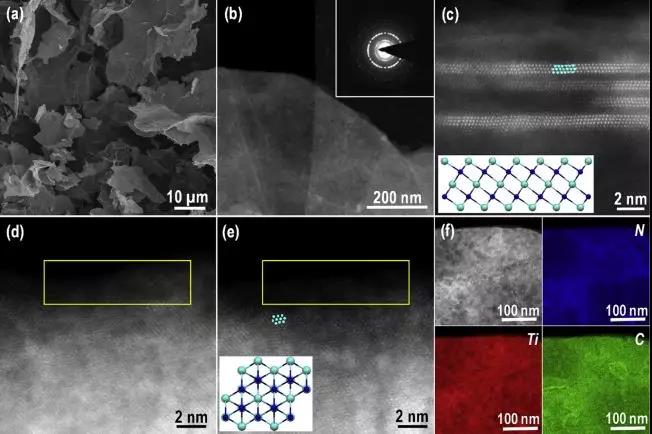
hotline:
17715390137
Tel/Wechat:
18101240246 (Technology)
0512-68565571
Email:mxenes@163.com (Sales Engineer)bkxc.bonnie@gmail.com
Scan the code to follow or search the official account on WeChat:
2D Materials Fronrier After paying attention,
click on the lower right corner to contact us,
Enter enterprise WeChat.
Professional Services Online


【Research Background】
Electrochemical capacitors and batteries are the most important energy storage devices in the era of energy consumption. Their different electrochemical energy storage mechanisms affect their respective energy and power densities. The diffusion of solid ions into the interior of the electrode material ensures a higher energy density, but relatively slow kinetics can result in lower power and longer charge and discharge times for the electrode material. Redox pseudocapacitance is mainly produced by a rapid and reversible Faraday reaction occurring on the surface of the electrode. The advantage is that it can store charge by electrostatic adsorption on the surface of the electrode material like an electric double layer capacitor (EDLC). Increase the high energy density with reduced fast dynamic response (IV). However, such charge transfer occurs only at the surface of the electrode material or at the interface with the electrolyte, which greatly limits the ability of charge storage. In order to further increase the energy density, a more effective strategy is to synthesize materials with well-defined structural features (ie, larger layer spacing or ion channels), allowing cations (such as Li + ) to be embedded in most electrode materials at high rates. The superiority of the intercalated tantalum capacitor is that there is no limitation of solid ion diffusion during charge transfer, and high-rate high-capacity charge storage can be realized. In addition to the common transition metal oxides, sulfides and phosphates with higher tantalum capacitance, researchers have developed a strong interest in designing high performance electrode materials with such intercalated tantalum capacitors.
[Introduction]
Recently, Professor Husam N. Alshareef of King Abdullah University of Science and Technology reported a unique two-dimensional (2D) heterostructure formed by the hybridization of graphite phase carbonitride (g-C3N4) and Ti3C2TxMxene. Provides significant tantalum capacitance characteristics and ultra-high lithium storage stability. It is worth noting that even at the high rate of 120C, the charge and discharge rate has little effect on the tantalum capacitance and the peak potential shift is small, which proves that there is no obvious diffusion limit in this heterostructure. It also reflects excellent kinetic properties. This excellent fast kinetics is due to the inherent chemical interface and electron coupling of g-C3N4 and MXene. Compared with pure MXene, it can synergistically improve and improve the electron transfer and lithium ion diffusion kinetics.
The results were published online in the internationally renowned academic journal Nano Energy under the title: Heterostructured MXene and g-C3N4 for high-rate lithium intercalation.
[Graphic introduction]

Figure 1 Schematic diagram of the MXene@CN heterostructure. The enlarged portion represents the hydrogen bond that drives the dicyandiamide molecule to self-assemble on the MXene surface (ie −NH2 •••O−Ti )
 0
0
Figure 2 MXene@CN heterostructure: (a) SEM image; (b) low magnification STEM image; (c)-(e) high angle annular dark field STEM image, (e) the same area as (d) After a long period of electron irradiation, the STEM image shows a significant decrease in the amorphous region after about 30 s; the illustrations in (c) and (e) correspond to the atomic structure of MXene: the cyan and dark blue atoms represent Ti and C atoms. (f) Distribution of N, Ti and C elements.

Fig. 3 Cyclic voltammetry curve of MXene@CN and pure MXene phase (a), kinetic characteristics (b), (c) Calculate b value based on linear fitting results of positive and negative peak currents, scanning rate from 0.1 to 100 mVs- 1 Kinetic analysis of heterostructures and two electrode materials (d)-(e); (f) Relationship between positive electrode potential change and scan rate of two electrode materials.

Figure 4 (a) Schematic diagram of the molecular structure of g-C3N4 with different types of C and N atoms; (b) Electron energy loss spectrum, inset of fine structure, (c) 13C DNP-NMR spectrum, (d) 15NDNP-NMR spectrum, (e) Electron paramagnetic resonance spectroscopy, (f) MXene and g-C3N4 N 1s core energy levels.
[Summary of this article]
The 2DMXene and graphite phase carbonitride g-C3N4 heterostructure electrode prepared in this study have excellent lithium storage capacity, such as high capacity and excellent rate performance and long cycle life. These excellent electrochemical properties are due to the good chemical interfacial reaction and electronic coupling of the MXene material itself, which synergistically promote the electron transfer and diffusion kinetics that occur during lithium storage. This method opens up a new way for the design of MXene-based two-dimensional heterostructure materials, which can effectively improve the energy and power density of electrochemical energy storage devices.
Literature link:
https://doi.org/10.1016/J.NANOEN.2019.104030
Source: WeChat public account MXene Frontier

| Reminder: Beijing Beike New Material Technology Co., Ltd. supplies products only for scientific research, not for humans |
| All rights reserved © 2019 beijing beike new material Technology Co., Ltd 京ICP备16054715-2号 |